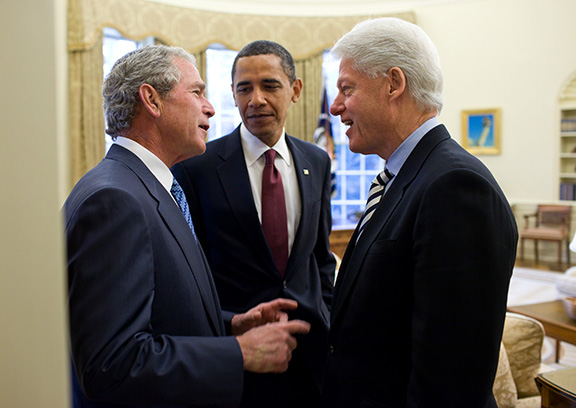Sure it’s easy to have a breakthrough leadership brand when you’re the leader of the free world. How can an unknown startup entrepreneur impact others? Can emotions help move your team to action?
What do you need to know that helps you become better at influencing others in your life? What might you learn from two former Presidents that takes your life and organization to a different level?
All great leaders understand the power of emotions to impact and influence others. Most good leaders are in control of their emotions. Most are level headed, and able to get good results from the people around them. Great serving leaders are emotionally intelligent.
It’s funny to me that President Clinton is known for feeling others’ pain. Many comedians made a living imitating his empathy. As leaders, it’s easier to remain unmoved by others’ emotions. To act as a robot while terrible things happen around them. A true serving leader is willing to step into the pain to find a way to connect with others.
Are you willing to tap into others’ emotions so that you can connect them to a greater cause than themselves? I’ve seen many Presidents deal with terrible events in their terms. Few were as emotionally available as President Clinton was.
It would be easy to say President Clinton was very empathetic to others’ pain and success. When you talk to people around him you realize he is incredibly gifted in making you feel like the most important person in the room. This skill allowed him to get many things accomplished as President and even today as a serving leader he connects with people one on one.
So what is President Clinton’s secret? I believe he is very good at remembering what’s important to you. He has a near photographic memory and he is able to remember little facts about the people he meets. He also understands the power of touch to create lasting memories. He is a tactile leader.
When growing up, I had a minister with a similar leadership style. When he met you he would touch you. Somehow he knew where to touch, where it would put the person at ease. President Clinton has a similar style. Even the most hardened men could be influenced by this single gesture.
I’m not sure how to advise you on this, but I know when I worked in hospice it became very natural to touch someone to let them know you were there. Doesn’t have to last long but it helps break down barriers much faster than almost any other communication skill I’ve seen.
When talking about emotions I feel it is important to talk about how emotions can be harnessed. President Bush harnessed his team’s emotions to keep them moving quickly during an emotionally challenging time. Many of his team had lost friends during the 9/11 terrorists’ attacks.
When I went to Washington DC after 9/11, I was struck by how raw emotions can be harnessed to help a leader influence and move others. When I was briefed about meeting my potential clients I was told what to expect in meeting with President Bush’s leadership team members.
It’s not unusual for internal champions to brief me on what to expect from their bosses. When describing Secretary Rumsfeld, I was told to not expect to sit down, be prepared to answer questions quickly and completely, and not to hold back when asked challenging questions. If something was unclear, ask for additional clarification. How would you deal with a leader like this?
What was unusual was being told they wanted to make sure I was committed to making a difference in the work I was doing. They then told me how committed everyone was to reopening the Pentagon. I was told several stories about the men and women who perished in the attack and then given a tour that would shake even the most self-assured leader.
Where I would be speaking that day had paintings on the walls that I remembered from my high school text books. They reminded me that I was working in a hallowed place and failure was not an option. Each individual would share their story and why they were committed to what we were achieving as a team. They then asked what I hoped to accomplish and why. I can tell you I’ve been paid a lot more money to work for clients, but I’ve never been more committed to the goals they shared with me.
As entrepreneurs, we need to be willing to share our stories over and over. Steve Jobs would spend weeks preparing for his new product launch presentations. He would share the Apple legend every time and repeat it often so you could feel his commitment to his customers’ experience. Great leaders let emotions move people more quickly than facts.
Finally, both men understand how things impact them emotionally. They are masters of touching people with their ability to connect. It was not unusual for either man to express their feelings about what was going on around them. Both experienced triumphs and tragedies as Presidents. Both men allowed their emotions to help share their message for future generations. By sharing their emotions they were able to move people to action more quickly than just sharing a story.
It is critical for you to get people not only to see the benefits for today but how this will change the world moving forward. When you experience failures and you are best served to learn how to use those emotions as a catalyst for change.
See you next week.

